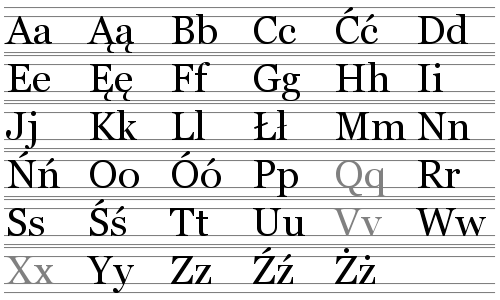The Kick-Butt, Easy Guide to the Polish Alphabet
Polish people are proud of their language. Why? It’s one of the toughest languages out there. English speakers will find a whole range of new sounds. But, as always, the first step is to learn the alphabet. So, let’s learn the Polish Alphabet. Take this lesson and….
- Read, review and repeat as much as possible.
- Again, review – this is all about memorization not “intelligence”
- Print this out to serve as a guide (very helpful for future review)
- Write it all out with paper and pen
- Watch the video below
✅ Hey, if you REALLY want to learn & speak Polish with a complete learning program, (500+ audio/video courses, apps, study tools and more) Sign up at PolishPod101 (click here) and start learning! I recommend ’em as a teacher & learner.
Part 1: So, What’s the Deal with the Polish Alphabet?
The Poles adopted the Latin alphabet in the 12th century. But, it was not really built for Polish sounds. What did they do? In the Middle Ages, they adjusted it with new, fun rules and squiggly lines. As a result, the Polish alphabet ended up with 32 letters (23 consonants and 9 vowels) in it – traditionally listed in the order from “A” to “Ż”. Take a look below:

The good news is, you DON’T have to learn how to write the Polish alphabet. If you can read these words I write, you’re good.
What about the Polish sounds and pronunciation?
| Polish Letter | Audio | English Equivalent |
| A | A in large | |
| Ą | nasal o as own or French an in français | |
| B | B in bed | |
| C | Ts in pits | |
| Ć | Ch in cheap | |
| D | D in dog | |
| E | E in bed | |
| Ę | nasal e | |
| F | F in fingers | |
| G | G in go | |
| H | H in Scots’ loch | |
| I | ee in meet | |
| J | y in yes | |
| K | K in king | |
| L | L in light | |
| Ł | ll in will | |
| M | M in men | |
| N | N in not | |
| Ń | Ny in canyon | |
| O | O in British English long | |
| Ó | Oo in boot | |
| P | P in spot | |
| R | Trilled r | |
| S | S in sea | |
| Ś | Sh in sheep | |
| T | T in start | |
| U | Oo in boot | |
| W | W in vow | |
| Y | short i as in bit | |
| Z | Z in zoo | |
| Ź | S in vision | |
| Ż | S in vision |
What does it sound like? Just play the video below:
So… what’s different? What are the special Polish alphabet rules? Let’s get into it.
Part 2.1 How’s it different from English? The Diacritics – Or Little Signs
First of all, the Polish alphabet includes some letters with diacritics. What are diacritics? These little signs and squiggles as you’ll see below. Look…
- the over-dot (called the “kropka”) Polish – (ż)
- the tail at the bottom (in Polish it’s called “ogonek”) – (ą),(ę);
- the stroke or strike-through (ł)
- the accent mark on top (in Polish “kreska”) – (ć, ń, ó, ś, ź).
As such, you will find in letters that look like this: “ą”, “ę”, “ó”, “ł”, “ń”, “ć”, “ś”, “ź” and “ż.” These are separate, unique letters in the Polish alphabet. You will learn all of them here. All learners must learn them initially.
- Tip: Also remember – letters “q”, “x”, “v” and “z” are used just in foreign words! You’ll never see them for regular Polish words.
 Part 2.2 How’s it different from English? The Pronunciation
Part 2.2 How’s it different from English? The Pronunciation
✧ Nasal vowels “ą” and “ę” – pronunciation
The pronunciation of the nasal vowels “ą” and “ę” depends on the following consonant. For example “ę” might be pronounced like “n”, “en”, “eu” or even “on”.
- piękna is pronounced as – pienkna – meaning beautiful
- męski is menski – meaning male.
Nasal vowel “ą”
To say “ą”, round your lips and say “ow” (like wow), after that, just touch the lower teeth with your tongue andsay “n”. Now, lets get into the rules that depend on the consonants that come after ą.
- If the next consonant is (f, h, ch, rz, sz, ś, w, s, z, ź or ż) –
- we pronounce it like English [ɔ̃] – mądry [m{ ɔ̃ }dry] – clever, like English marathon;
- If the next consonant is (b or p) –
- we pronounce it like English [ɔm] – Dąb [d{ɔm}b] – oak, like English bomb;
- If the next consonant is (c, cz, d, dz, dż or t) –
- we pronounce it like English [ɔn] – Zając [zaj{ɔn}c] – hare, like English monster.
- If the next consonant is (ć or dź) –
- we pronounce it like English [ɔɲ] – Ciąć [ci{ɔɲ}ch] – cut, like English cognac;
- If the next consonant is (k or g) –
- we pronounce it like English [ɔŋ] – wyciąg [vych[ɔŋ]g] – lift, like English along;
✧ Nasal vowel “ę”
To say “ę”, widen your lips and say “eu” (like “you”), after that, just touch the lower teeth with your tongue and say “n”. Now, the rules:
- If the next consonant is (k or g) –
- we pronounce it like English [eng] – Piękna [pi{ ɛŋ}kna] – beautiful, like English length;
- If the next consonant is (ć or dź) –
- we pronounce it like English [en] – Część [che{ ɛŋ}shch] – part, like English lent;
- If the next consonant is (c, cz, d, dz, dż or t) –
- we pronounce it like English [en] – wszędzie [vsh[ɛn]dzie] – everywhere, like English pen;
- If the next consonant is (p or b) –
- we pronounce it like English [em] – zęby [z[ɛm]by] – teeth, like English empty;
- If the next consonant is (ch, f, h, rz, s, sz, ś, w, z, ź or ż) –
- we pronounce it like English [ɛ̃] – męskie [m[ɛ̃]skie] – male, like English agent;
- If it’s in the end of the word –
- we pronounce it like English [ɛ] – robię [robi[ɛ]] – I’m doing, like English lieu;
Part 2.3 How’s it different from English? Digraphs and Trigraphs
There are a lot of digraphs (combination of 2 letters) and one trigraphs(combination of 3 letters) in the Polish alphabet. There’s only one way to remember them – you have to learn them by heart.
Digraphs: There are 7 digraphs in Polish language:
- “dz”
- “ch”
- “dż”
- “dź”
- “cz”
- “sz”
- “rz”
It’s very important to understand how to pronounce them.
- Ch – [x], for example „choinka” – Christmas tree; the pronunciation is between English Lochness and American heart.
- Cz – [ʈ͡ʂ], for example „ cześć” – part; the pronunciation is like English “catch”.
- Dz – [d͡z], for example „ dzwon” – bell; the pronunciation is like English “goods”.
- Dż – [d̠͡ʑ], for example „ dżinsy” – jeans; the pronunciation is like English “jam”.
- Dź – [ɖ͡ʐ], for example „ dźwięk” – sound; the pronunciation is like English “gorgeous”.
- Rz – [z], for example „ rzeka” – river; the pronunciation is like English “ginger”.
- Sz – [ʂ], for example „ szeroki” – wide; the pronunciation is like English “share”.
Trigraphs: There is only one trigraph “dzi” in Polish language.
- Dzi – [ʥ̑], for example „ dziwny” – strange; the pronunciation is like English “giant”.
Part 2.4 How’s it different from English? Other Notes
Here are some other differences:
- Ć – [ʧ] – (for example “ćakra”) sounds like English [cz] but softer, English example – Czech Republic.
- Ł – [ɫ] – (for example “ładna”), it’s completely different from “L”, sounds more like English [w]or [v], English example – moving.
- Ó – [u] -(for example “mówić”), sounds like English [u] or double “o”, English example – spook.
- Ź – [u] -(for example “źródło”), sounds like digraph [ɖ͡ʐ] or English [j], English example – Jordan.
- Ż – [u] – (for example “żwir”), sounds like digraph [d̠͡ʑ] or English [s], English example – pleasure.
Part 3: Similarities That You Will Easily Understand
These are letters, which sounds the same like in English:
[a] – mama, [b] – brat, [d] – dawno, [e] – chemiczny, [f] – fajny, [g] – góra, [h] – hala, [i] – Internet, [k] – kąt, [l] – , [m] – morze, [n], [o] – opinie, [p] – prosty, [r] – narty, [s] – słońce, [t] – turystyka, [u] – duży, [w] – wynik, [y] – czynny and [z] – ząb.
The Polish alphabet is considered a tough alphabet. But, it’s not terrible. Just memorize the Digraphs and Trigraphs. Review the pronunciations of the “unique” letters and that’s it. There is no difference between Polish and English cursive, so you don`t have to learn how to write.
And that’s it.
– PDF Jeff
P.S. I recommend this for Polish learners: If you REALLY want to learn Polish with a complete learning program – 600+ audio/video lessons by Polish teachers – Sign up for free at PolishPod101and start learning!


Ł should be w in will or w in want